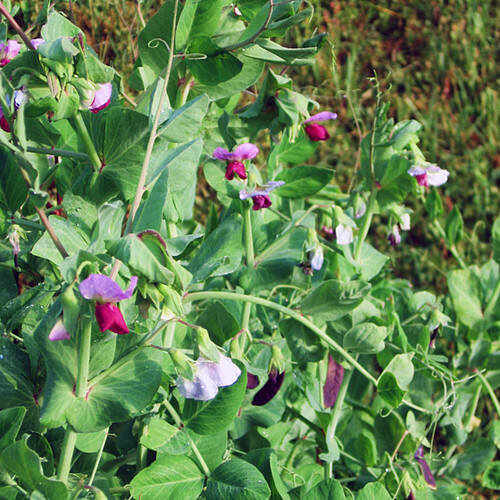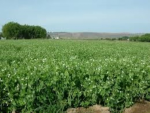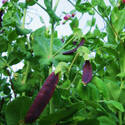SO I am pretty excited. For the last coupe of years have been trying to grow a dry soup pea. Long story short the deer love them. I was down to one packet of Capucijner Peas. Finally got deer fixed (8 ft high fence) and planted them. They did great. Harvested 3/4 of a lb from one small packet. Going to eat half to see if we like them and save the other half to plant. It will be a couple years until we can grow enough to really put a dent in our pea soup consumption but it is another step for us. Our yellow eye beans did well also.
You are using an out of date browser. It may not display this or other websites correctly.
You should upgrade or use an alternative browser.
You should upgrade or use an alternative browser.
Seed Capucijner Peas
- Thread starter mecoastie
- Start date

Quantity:
Current Stock:
♥ Add to Wish List
Description
Harvested from the gardens at Monticello.
The Blue-podded Capucijner (cap-ou-SIGH-nah) is a hardy pea first grown by the Franciscan Capuchin monks in Holland and Germany during the early 1600's. Its particularly beautiful, bi-colored flowers are lilac-pink and wine-red, fading to blue as they wilt; pods are deep maroon to inky purple, fading to blue and leathery brown when mature. It is best used as a soup pea by picking when the pods are full; but it can also be grown as an edible-podded sugar pea by harvesting before peas have developed.
This English, or shelling, pea prefers cool, moist conditions. Direct sow the seeds in fertile garden loam 4-8 weeks before the last spring frost. Monticello gardeners support the twining vines with tall branches, or "pea sticks". Approximately 15-20 seeds per packet.
| Exposure | Planting Method | Planting Depth | Days to Emerge | Plant Spacing | Days to Maturity | Size at Maturity |
|---|---|---|---|---|---|---|
Full Sun | Direct Sow | 1" | 7-14 | 2-3"; rows 24" apart | 70-100 | 5' |
China Connection
TB Fanatic


Field peas are a quick growing legume with an upright growth habit. Often used as a break crop for disease control and offering soil nitrogen improvement benefits, peas are included in most green manure blends and are an important component of rotational cropping.
Dun peas are the most common field pea in Australia with a number of varieties available dependant on season and demand.

Field Peas
Love field peas. I grow them every year. The variety called Colossus have a bigger pea, therefore, it doesn't take as long to shell. They are so easy to fix...shell them, rinse, cover with water 1" above peas, add a little uncooked bacon or bacon grease and let them come to a boil. SOooo good. I've seen bags of these in the freezer vegetable section at Food Lion (N Carolina). They are not like traditional peas as they do not tolerate frost. The long pods turn brown when it's time to pick or you can pick when they're green but, of course, they are harder to shell. They also freeze and can well.
China Connection
TB Fanatic
Zipper Cream Pea | Premium Garden Seeds | Hoss Tools


Zipper Cream Pea
$3.99 – $39.99
Zipper Cream Pea is a field pea variety that’s been a southern staple for years. Creamy, delicious white peas that are easy to shell. Heat-tolerant and heavy-yielding. Pisum sativum. 65 days to maturity. Treated.
1,800 seeds per lb
" style="box-sizing: inherit; border: 0px; font-size: 17px; font-style: inherit; font-weight: inherit; margin: 0px; outline: 0px; padding: 0px; vertical-align: baseline; display: flex; align-items: center; cursor: pointer;">
200 seeds
$3.99
Dismiss notification
I agree to receive restock notifications via email.
Enter your email address to join the waitlist for this product
Request Inventory Alert
" style="box-sizing: inherit; border: 0px; font-size: 17px; font-style: inherit; font-weight: inherit; margin: 0px; outline: 0px; padding: 0px; vertical-align: baseline; display: flex; align-items: center; cursor: pointer;">
1 pound
$12.99
" style="box-sizing: inherit; border: 0px; font-size: 17px; font-style: inherit; font-weight: inherit; margin: 0px; outline: 0px; padding: 0px; vertical-align: baseline; display: flex; align-items: center; cursor: pointer;">
5 pounds
$39.99
Out of stock
I agree to receive restock notifications via email.
Enter your email address to join the waitlist for this product
Request Inventory Alert
Zipper Cream Pea is a southern favorite the tastes like a beautiful blend between a cowpea and English pea. Plants grow to 2-3′ tall and are semi-vining, which provides excellent ground cover for weed suppression during growth. Each plant produces many 6-9″ pods which are medium green in color and will fade slightly as peas mature. Plants will provide several harvests throughout their lifetime. Zipper Cream is very heat-tolerant and performs well when planted in late spring and early fall.
Zipper Cream Pea gets it’s name from the ease of shelling and the creamy texture of the finished product. Each pod has a string that acts as a zipper that makes them a very easy variety to shell. The peas are large and creamy white peas that melt in your mouth when cooked. This variety is excellent when prepared fresh, but also preserves extremely well when blanched and frozen.
We recommend planting Zipper Cream Pea using a walk-behind planter like our Hoss Garden Seeder. Use a #5 seed plate, but always check the hole size and modify if necessary. Because it has a semi-vining growing habit, allow 3-4′ of growing space for each row. Field peas, or “crowder peas”, do very well when planted on double rows. Plant two rows about 6″ apart, then skip over 3-4′ and plant another double row. This will allow you to maximize garden space and produce more vegetables per square foot of garden. Peas should be harvested when pods are full and shelling is easy. If the pods do not shell easily, they likely need to stay on the plant longer.
Zipper Cream Pea Planting Information
Planting Method: direct seed
When to Plant: after last frost
Planting Depth: 1″
Seed Spacing: 3-4″
Row Spacing: 3-4′
Days to Maturity: 65
Pest Resistance: Root Knot Nematode

Zipper Cream Pea
Be sure to check out our Cow Pea Growing Guide for more tips & tricks on successfully growing cow peas in your garden. Zipper Cream Pea is a southern favorite the tastes like a beautiful blend between a cowpea and English pea. Plants grow to 2-3' tall and are semi-vining, which provides...
Txkstew
Veteran Member
I've never tried the peas in the OP, but one year me and a buddy put in a 20' by 100' patch of three different types. Purple Hull Cow peas, Cream Zippers, and Crowder peas. I had a working tractor at the time, and a big PTO driven tiller. The pea patch was a hard, gumbo clay strip, that had been excavated from a county drainage ditch on my property. It tilled up to a clumpy patch, that wasn't real easy to row up, but we did. After watering in the fresh planted pea seed, damn if they didn't all come up thick and vigorous, which was unnerving to walk through the rows with all the snakes that lived in that ditch.
The Cow peas came off first, and we harvested a bunch of them. Then we had a big rain event, and some kind of blight broke out on the leaves. The Cream Zippers were ready to harvest by then, and we were standing there looking, and I said we need to pick them tomorrow morning. They were big and fat like the pic above in this thread. When we went out the next morning to pick, they were all gone, and there was deer tracks all around the patch. End of that crop.
There are big pea farms around here, that constantly fight off the deer. A friend of mine tried to control them for one farmer, by putting fire crackers, with the fuses threaded into a long piece of cotton string and hung in a tree. As the string slowly burned up, a fire cracker would pop every now and then. It didn't work, the deer got used to it. I've heard of farmers staking out guard dogs around the perimeter of the field, but when the dogs went to sleep, the deer just ran past the dogs and into the field.
So, one night, my friend went out into the field with a spot light, and the deer were so full of peas, they couldn't even get up to run away. He shot 23 deer that night in the field, which is legal in Texas to protect crops. He spent all the next day processing the deer for freezer storage at everyone he knew that had freezer space.
The Cow peas came off first, and we harvested a bunch of them. Then we had a big rain event, and some kind of blight broke out on the leaves. The Cream Zippers were ready to harvest by then, and we were standing there looking, and I said we need to pick them tomorrow morning. They were big and fat like the pic above in this thread. When we went out the next morning to pick, they were all gone, and there was deer tracks all around the patch. End of that crop.
There are big pea farms around here, that constantly fight off the deer. A friend of mine tried to control them for one farmer, by putting fire crackers, with the fuses threaded into a long piece of cotton string and hung in a tree. As the string slowly burned up, a fire cracker would pop every now and then. It didn't work, the deer got used to it. I've heard of farmers staking out guard dogs around the perimeter of the field, but when the dogs went to sleep, the deer just ran past the dogs and into the field.
So, one night, my friend went out into the field with a spot light, and the deer were so full of peas, they couldn't even get up to run away. He shot 23 deer that night in the field, which is legal in Texas to protect crops. He spent all the next day processing the deer for freezer storage at everyone he knew that had freezer space.



